Public Health Project: Diabetes Intervention in Harrow, UK
VerifiedAdded on 2020/10/05
|26
|8391
|378
Project
AI Summary
This project focuses on health inequalities related to type 2 diabetes, specifically within the Harrow borough of the UK. It begins with an introduction to the prevalence of diabetes, the rationale for the study, and the project's aims and objectives, which include identifying factors causing health inequalities among obese people and developing an intervention plan for diabetes prevention. The project then delves into the epidemiology of type 2 diabetes, discussing its causes, risk factors, and social determinants. The identified needs are further explored by examining the social determinants of health and health inequalities within the context of Harrow. The project then outlines evidence-based service provisions and health strategies, including the Diabetes Prevention Program (DPP), and assesses the effectiveness of various diabetes health interventions. Finally, the project proposes a detailed intervention plan, considering public health ethics, settings for delivery, data collection methods, resources, stakeholder analysis, and a timeline for implementation. The overall goal is to address the public health issue of diabetes and improve health outcomes for obese individuals in Harrow.
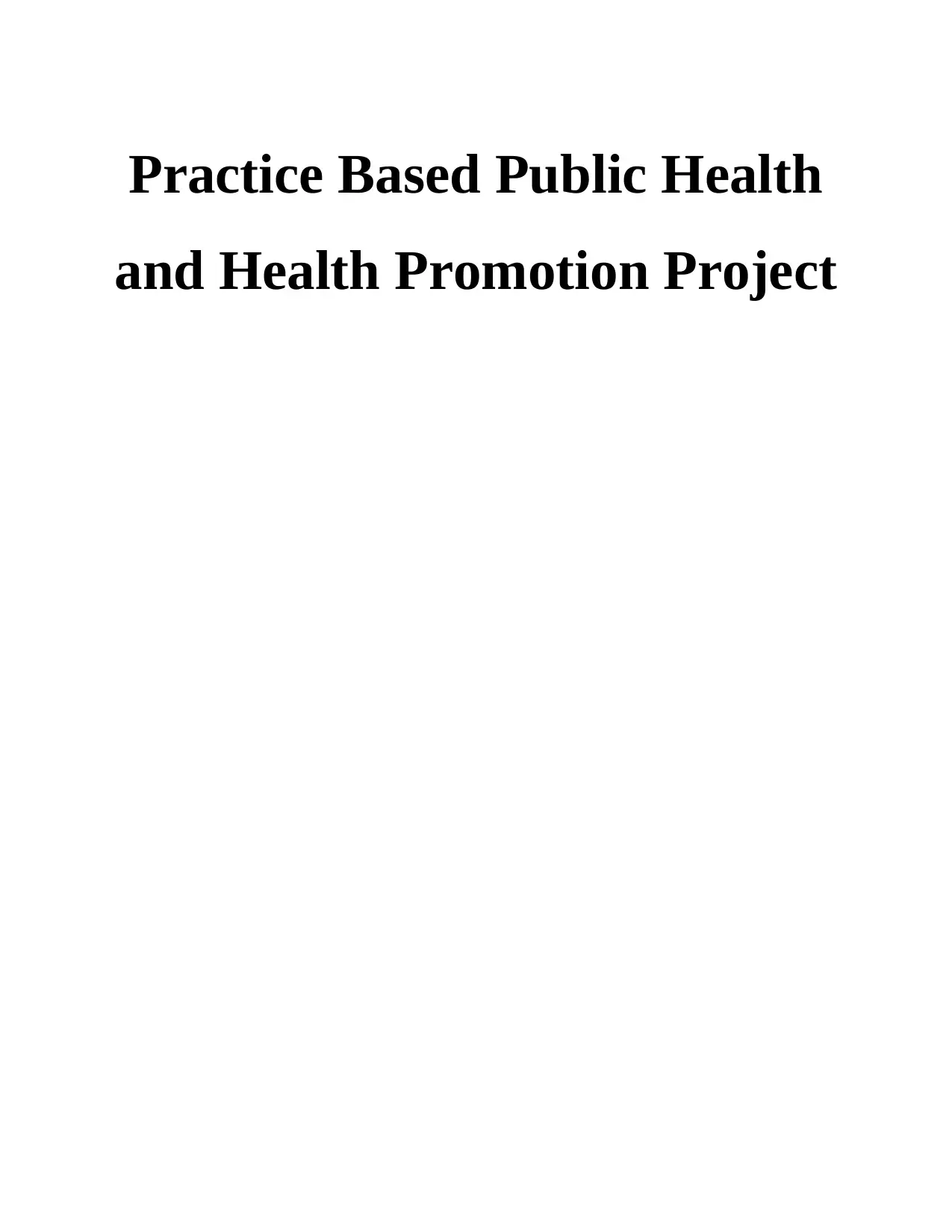
Practice Based Public Health
and Health Promotion Project
and Health Promotion Project
Paraphrase This Document
Need a fresh take? Get an instant paraphrase of this document with our AI Paraphraser
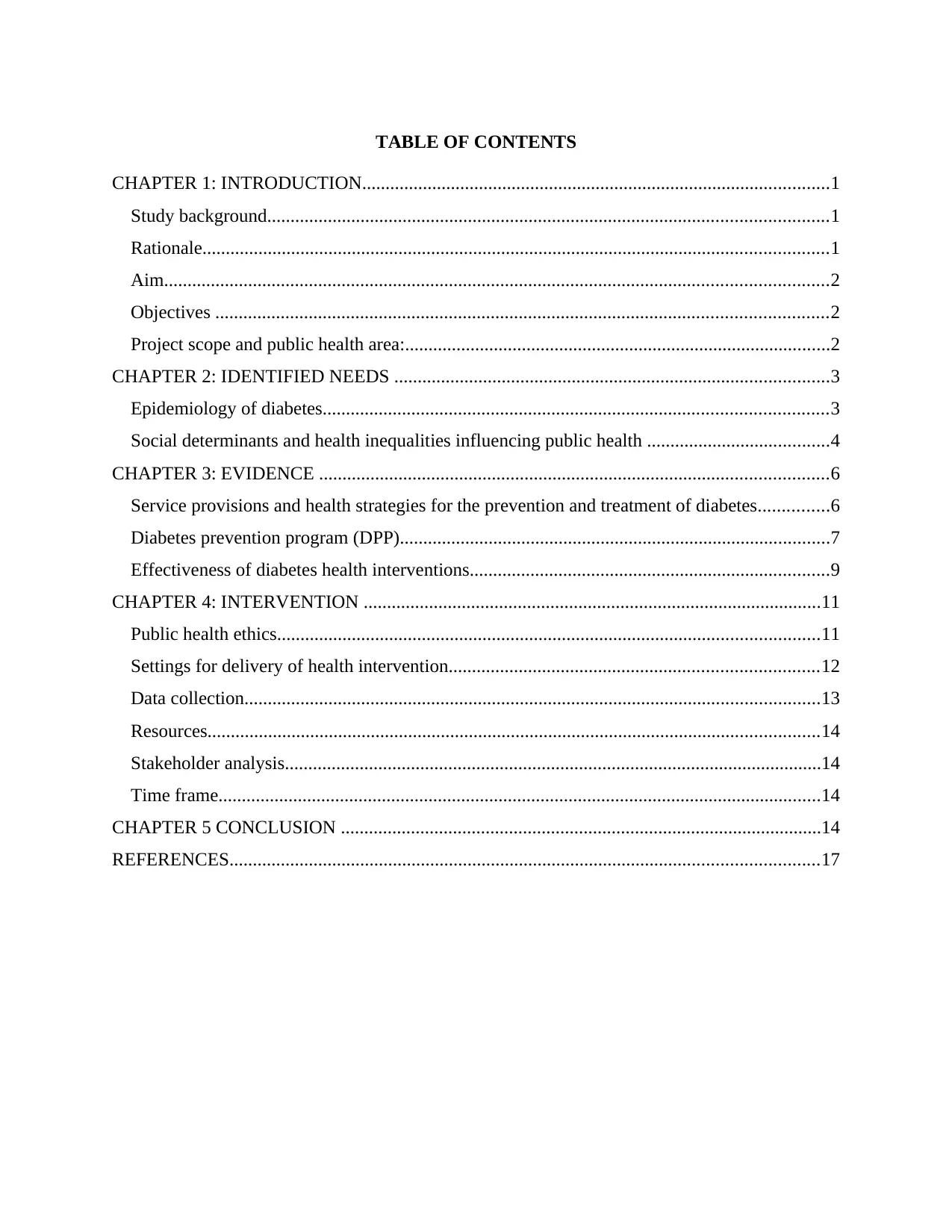
TABLE OF CONTENTS
CHAPTER 1: INTRODUCTION....................................................................................................1
Study background........................................................................................................................1
Rationale......................................................................................................................................1
Aim..............................................................................................................................................2
Objectives ...................................................................................................................................2
Project scope and public health area:...........................................................................................2
CHAPTER 2: IDENTIFIED NEEDS .............................................................................................3
Epidemiology of diabetes............................................................................................................3
Social determinants and health inequalities influencing public health .......................................4
CHAPTER 3: EVIDENCE .............................................................................................................6
Service provisions and health strategies for the prevention and treatment of diabetes...............6
Diabetes prevention program (DPP)............................................................................................7
Effectiveness of diabetes health interventions.............................................................................9
CHAPTER 4: INTERVENTION ..................................................................................................11
Public health ethics....................................................................................................................11
Settings for delivery of health intervention...............................................................................12
Data collection...........................................................................................................................13
Resources...................................................................................................................................14
Stakeholder analysis...................................................................................................................14
Time frame.................................................................................................................................14
CHAPTER 5 CONCLUSION .......................................................................................................14
REFERENCES..............................................................................................................................17
CHAPTER 1: INTRODUCTION....................................................................................................1
Study background........................................................................................................................1
Rationale......................................................................................................................................1
Aim..............................................................................................................................................2
Objectives ...................................................................................................................................2
Project scope and public health area:...........................................................................................2
CHAPTER 2: IDENTIFIED NEEDS .............................................................................................3
Epidemiology of diabetes............................................................................................................3
Social determinants and health inequalities influencing public health .......................................4
CHAPTER 3: EVIDENCE .............................................................................................................6
Service provisions and health strategies for the prevention and treatment of diabetes...............6
Diabetes prevention program (DPP)............................................................................................7
Effectiveness of diabetes health interventions.............................................................................9
CHAPTER 4: INTERVENTION ..................................................................................................11
Public health ethics....................................................................................................................11
Settings for delivery of health intervention...............................................................................12
Data collection...........................................................................................................................13
Resources...................................................................................................................................14
Stakeholder analysis...................................................................................................................14
Time frame.................................................................................................................................14
CHAPTER 5 CONCLUSION .......................................................................................................14
REFERENCES..............................................................................................................................17
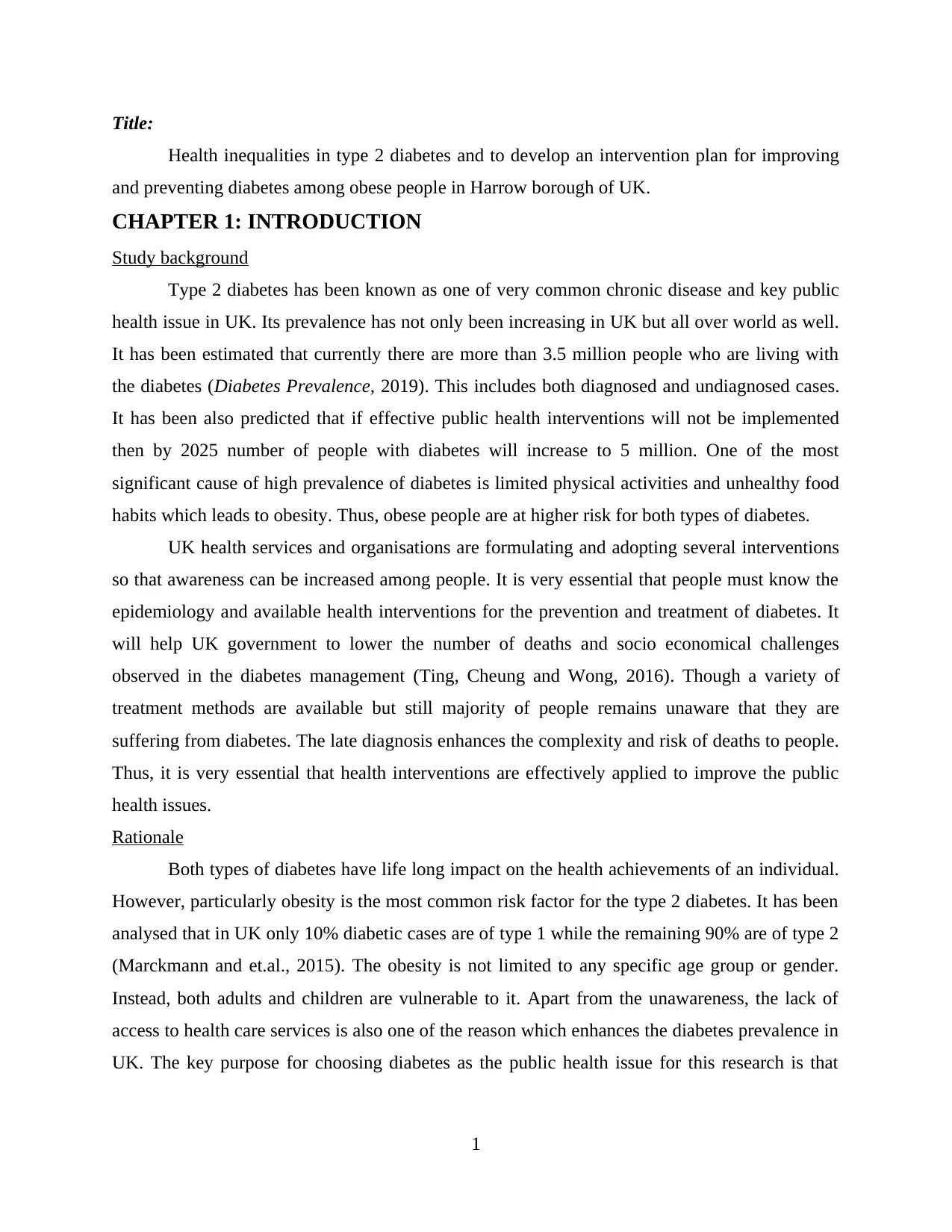
Title:
Health inequalities in type 2 diabetes and to develop an intervention plan for improving
and preventing diabetes among obese people in Harrow borough of UK.
CHAPTER 1: INTRODUCTION
Study background
Type 2 diabetes has been known as one of very common chronic disease and key public
health issue in UK. Its prevalence has not only been increasing in UK but all over world as well.
It has been estimated that currently there are more than 3.5 million people who are living with
the diabetes (Diabetes Prevalence, 2019). This includes both diagnosed and undiagnosed cases.
It has been also predicted that if effective public health interventions will not be implemented
then by 2025 number of people with diabetes will increase to 5 million. One of the most
significant cause of high prevalence of diabetes is limited physical activities and unhealthy food
habits which leads to obesity. Thus, obese people are at higher risk for both types of diabetes.
UK health services and organisations are formulating and adopting several interventions
so that awareness can be increased among people. It is very essential that people must know the
epidemiology and available health interventions for the prevention and treatment of diabetes. It
will help UK government to lower the number of deaths and socio economical challenges
observed in the diabetes management (Ting, Cheung and Wong, 2016). Though a variety of
treatment methods are available but still majority of people remains unaware that they are
suffering from diabetes. The late diagnosis enhances the complexity and risk of deaths to people.
Thus, it is very essential that health interventions are effectively applied to improve the public
health issues.
Rationale
Both types of diabetes have life long impact on the health achievements of an individual.
However, particularly obesity is the most common risk factor for the type 2 diabetes. It has been
analysed that in UK only 10% diabetic cases are of type 1 while the remaining 90% are of type 2
(Marckmann and et.al., 2015). The obesity is not limited to any specific age group or gender.
Instead, both adults and children are vulnerable to it. Apart from the unawareness, the lack of
access to health care services is also one of the reason which enhances the diabetes prevalence in
UK. The key purpose for choosing diabetes as the public health issue for this research is that
1
Health inequalities in type 2 diabetes and to develop an intervention plan for improving
and preventing diabetes among obese people in Harrow borough of UK.
CHAPTER 1: INTRODUCTION
Study background
Type 2 diabetes has been known as one of very common chronic disease and key public
health issue in UK. Its prevalence has not only been increasing in UK but all over world as well.
It has been estimated that currently there are more than 3.5 million people who are living with
the diabetes (Diabetes Prevalence, 2019). This includes both diagnosed and undiagnosed cases.
It has been also predicted that if effective public health interventions will not be implemented
then by 2025 number of people with diabetes will increase to 5 million. One of the most
significant cause of high prevalence of diabetes is limited physical activities and unhealthy food
habits which leads to obesity. Thus, obese people are at higher risk for both types of diabetes.
UK health services and organisations are formulating and adopting several interventions
so that awareness can be increased among people. It is very essential that people must know the
epidemiology and available health interventions for the prevention and treatment of diabetes. It
will help UK government to lower the number of deaths and socio economical challenges
observed in the diabetes management (Ting, Cheung and Wong, 2016). Though a variety of
treatment methods are available but still majority of people remains unaware that they are
suffering from diabetes. The late diagnosis enhances the complexity and risk of deaths to people.
Thus, it is very essential that health interventions are effectively applied to improve the public
health issues.
Rationale
Both types of diabetes have life long impact on the health achievements of an individual.
However, particularly obesity is the most common risk factor for the type 2 diabetes. It has been
analysed that in UK only 10% diabetic cases are of type 1 while the remaining 90% are of type 2
(Marckmann and et.al., 2015). The obesity is not limited to any specific age group or gender.
Instead, both adults and children are vulnerable to it. Apart from the unawareness, the lack of
access to health care services is also one of the reason which enhances the diabetes prevalence in
UK. The key purpose for choosing diabetes as the public health issue for this research is that
1
⊘ This is a preview!⊘
Do you want full access?
Subscribe today to unlock all pages.

Trusted by 1+ million students worldwide
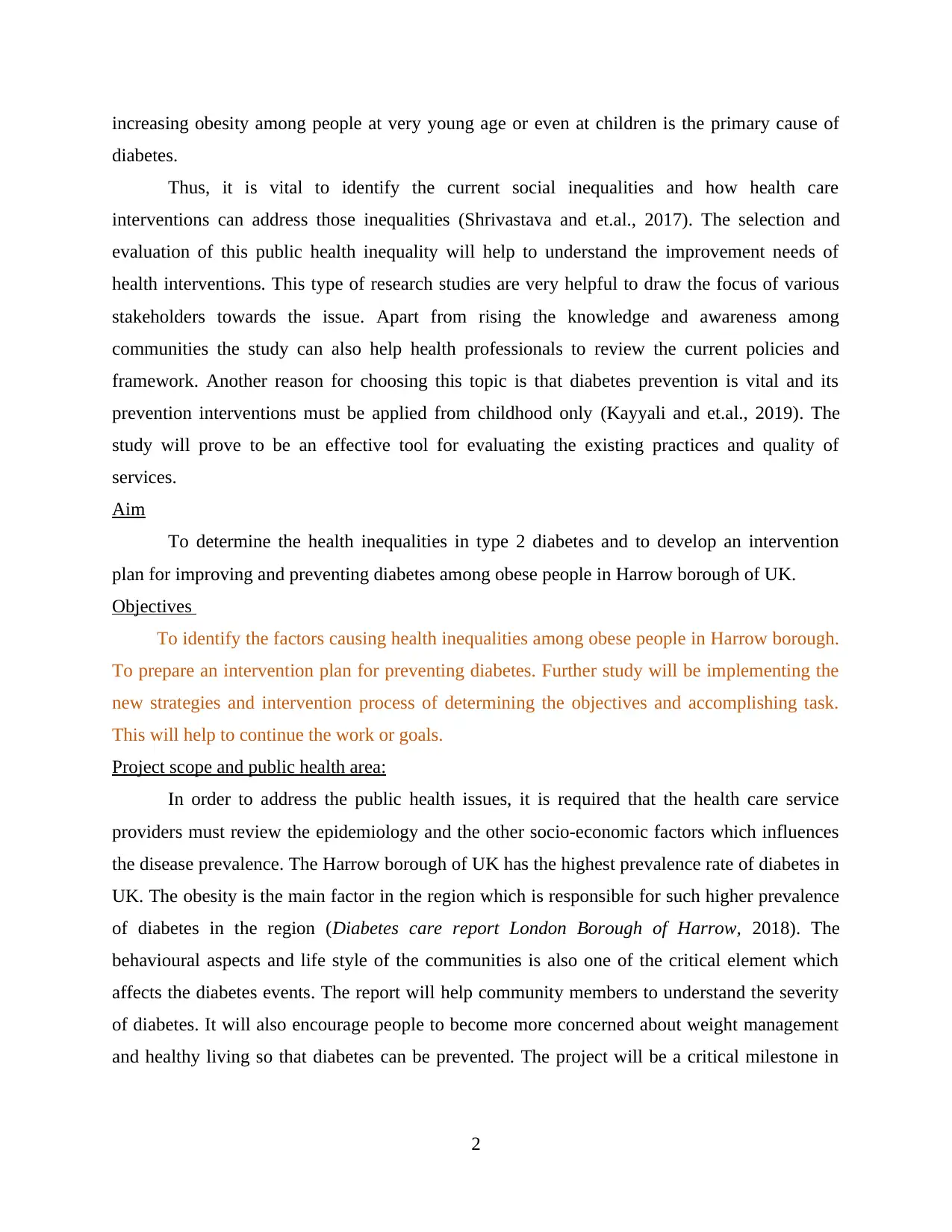
increasing obesity among people at very young age or even at children is the primary cause of
diabetes.
Thus, it is vital to identify the current social inequalities and how health care
interventions can address those inequalities (Shrivastava and et.al., 2017). The selection and
evaluation of this public health inequality will help to understand the improvement needs of
health interventions. This type of research studies are very helpful to draw the focus of various
stakeholders towards the issue. Apart from rising the knowledge and awareness among
communities the study can also help health professionals to review the current policies and
framework. Another reason for choosing this topic is that diabetes prevention is vital and its
prevention interventions must be applied from childhood only (Kayyali and et.al., 2019). The
study will prove to be an effective tool for evaluating the existing practices and quality of
services.
Aim
To determine the health inequalities in type 2 diabetes and to develop an intervention
plan for improving and preventing diabetes among obese people in Harrow borough of UK.
Objectives
To identify the factors causing health inequalities among obese people in Harrow borough.
To prepare an intervention plan for preventing diabetes. Further study will be implementing the
new strategies and intervention process of determining the objectives and accomplishing task.
This will help to continue the work or goals.
Project scope and public health area:
In order to address the public health issues, it is required that the health care service
providers must review the epidemiology and the other socio-economic factors which influences
the disease prevalence. The Harrow borough of UK has the highest prevalence rate of diabetes in
UK. The obesity is the main factor in the region which is responsible for such higher prevalence
of diabetes in the region (Diabetes care report London Borough of Harrow, 2018). The
behavioural aspects and life style of the communities is also one of the critical element which
affects the diabetes events. The report will help community members to understand the severity
of diabetes. It will also encourage people to become more concerned about weight management
and healthy living so that diabetes can be prevented. The project will be a critical milestone in
2
diabetes.
Thus, it is vital to identify the current social inequalities and how health care
interventions can address those inequalities (Shrivastava and et.al., 2017). The selection and
evaluation of this public health inequality will help to understand the improvement needs of
health interventions. This type of research studies are very helpful to draw the focus of various
stakeholders towards the issue. Apart from rising the knowledge and awareness among
communities the study can also help health professionals to review the current policies and
framework. Another reason for choosing this topic is that diabetes prevention is vital and its
prevention interventions must be applied from childhood only (Kayyali and et.al., 2019). The
study will prove to be an effective tool for evaluating the existing practices and quality of
services.
Aim
To determine the health inequalities in type 2 diabetes and to develop an intervention
plan for improving and preventing diabetes among obese people in Harrow borough of UK.
Objectives
To identify the factors causing health inequalities among obese people in Harrow borough.
To prepare an intervention plan for preventing diabetes. Further study will be implementing the
new strategies and intervention process of determining the objectives and accomplishing task.
This will help to continue the work or goals.
Project scope and public health area:
In order to address the public health issues, it is required that the health care service
providers must review the epidemiology and the other socio-economic factors which influences
the disease prevalence. The Harrow borough of UK has the highest prevalence rate of diabetes in
UK. The obesity is the main factor in the region which is responsible for such higher prevalence
of diabetes in the region (Diabetes care report London Borough of Harrow, 2018). The
behavioural aspects and life style of the communities is also one of the critical element which
affects the diabetes events. The report will help community members to understand the severity
of diabetes. It will also encourage people to become more concerned about weight management
and healthy living so that diabetes can be prevented. The project will be a critical milestone in
2
Paraphrase This Document
Need a fresh take? Get an instant paraphrase of this document with our AI Paraphraser
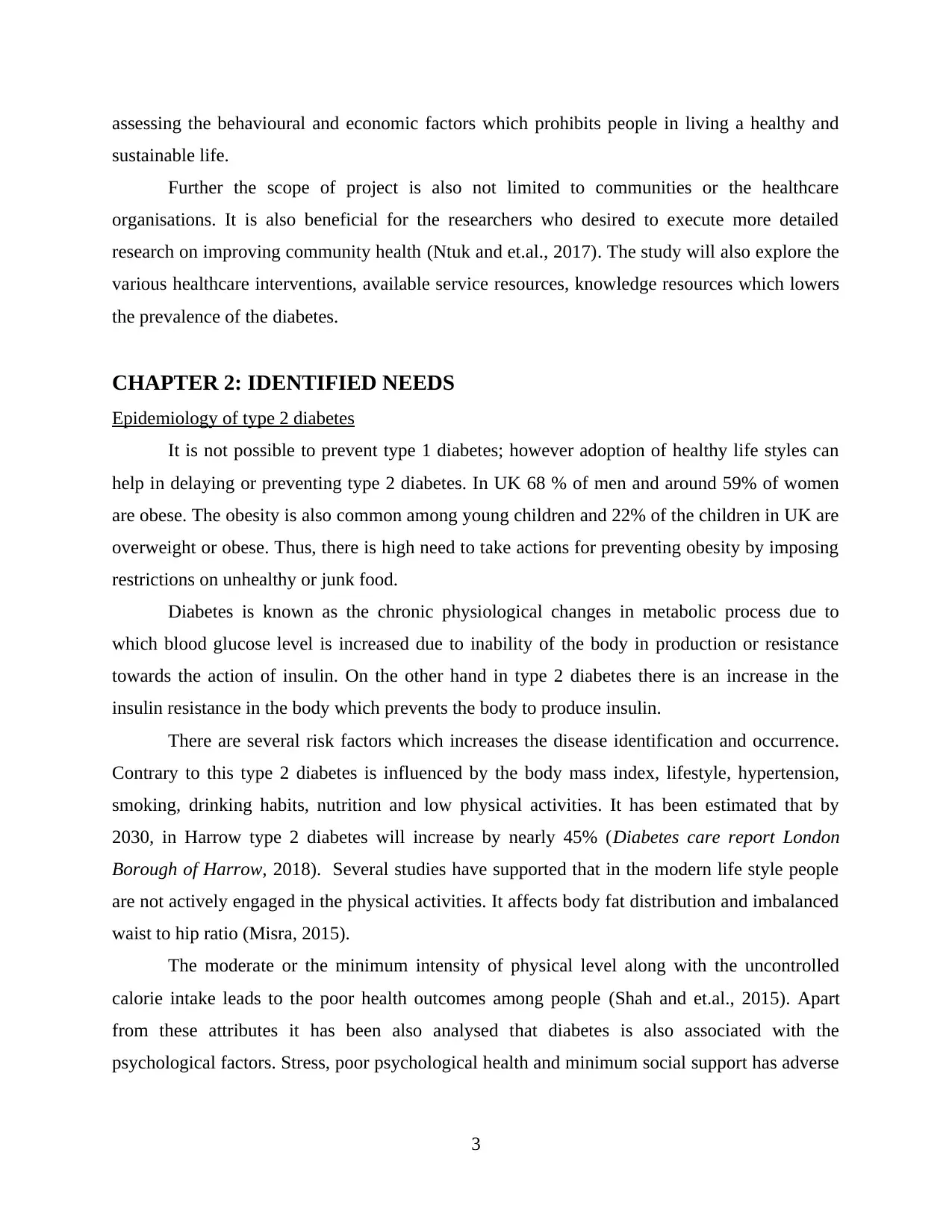
assessing the behavioural and economic factors which prohibits people in living a healthy and
sustainable life.
Further the scope of project is also not limited to communities or the healthcare
organisations. It is also beneficial for the researchers who desired to execute more detailed
research on improving community health (Ntuk and et.al., 2017). The study will also explore the
various healthcare interventions, available service resources, knowledge resources which lowers
the prevalence of the diabetes.
CHAPTER 2: IDENTIFIED NEEDS
Epidemiology of type 2 diabetes
It is not possible to prevent type 1 diabetes; however adoption of healthy life styles can
help in delaying or preventing type 2 diabetes. In UK 68 % of men and around 59% of women
are obese. The obesity is also common among young children and 22% of the children in UK are
overweight or obese. Thus, there is high need to take actions for preventing obesity by imposing
restrictions on unhealthy or junk food.
Diabetes is known as the chronic physiological changes in metabolic process due to
which blood glucose level is increased due to inability of the body in production or resistance
towards the action of insulin. On the other hand in type 2 diabetes there is an increase in the
insulin resistance in the body which prevents the body to produce insulin.
There are several risk factors which increases the disease identification and occurrence.
Contrary to this type 2 diabetes is influenced by the body mass index, lifestyle, hypertension,
smoking, drinking habits, nutrition and low physical activities. It has been estimated that by
2030, in Harrow type 2 diabetes will increase by nearly 45% (Diabetes care report London
Borough of Harrow, 2018). Several studies have supported that in the modern life style people
are not actively engaged in the physical activities. It affects body fat distribution and imbalanced
waist to hip ratio (Misra, 2015).
The moderate or the minimum intensity of physical level along with the uncontrolled
calorie intake leads to the poor health outcomes among people (Shah and et.al., 2015). Apart
from these attributes it has been also analysed that diabetes is also associated with the
psychological factors. Stress, poor psychological health and minimum social support has adverse
3
sustainable life.
Further the scope of project is also not limited to communities or the healthcare
organisations. It is also beneficial for the researchers who desired to execute more detailed
research on improving community health (Ntuk and et.al., 2017). The study will also explore the
various healthcare interventions, available service resources, knowledge resources which lowers
the prevalence of the diabetes.
CHAPTER 2: IDENTIFIED NEEDS
Epidemiology of type 2 diabetes
It is not possible to prevent type 1 diabetes; however adoption of healthy life styles can
help in delaying or preventing type 2 diabetes. In UK 68 % of men and around 59% of women
are obese. The obesity is also common among young children and 22% of the children in UK are
overweight or obese. Thus, there is high need to take actions for preventing obesity by imposing
restrictions on unhealthy or junk food.
Diabetes is known as the chronic physiological changes in metabolic process due to
which blood glucose level is increased due to inability of the body in production or resistance
towards the action of insulin. On the other hand in type 2 diabetes there is an increase in the
insulin resistance in the body which prevents the body to produce insulin.
There are several risk factors which increases the disease identification and occurrence.
Contrary to this type 2 diabetes is influenced by the body mass index, lifestyle, hypertension,
smoking, drinking habits, nutrition and low physical activities. It has been estimated that by
2030, in Harrow type 2 diabetes will increase by nearly 45% (Diabetes care report London
Borough of Harrow, 2018). Several studies have supported that in the modern life style people
are not actively engaged in the physical activities. It affects body fat distribution and imbalanced
waist to hip ratio (Misra, 2015).
The moderate or the minimum intensity of physical level along with the uncontrolled
calorie intake leads to the poor health outcomes among people (Shah and et.al., 2015). Apart
from these attributes it has been also analysed that diabetes is also associated with the
psychological factors. Stress, poor psychological health and minimum social support has adverse
3
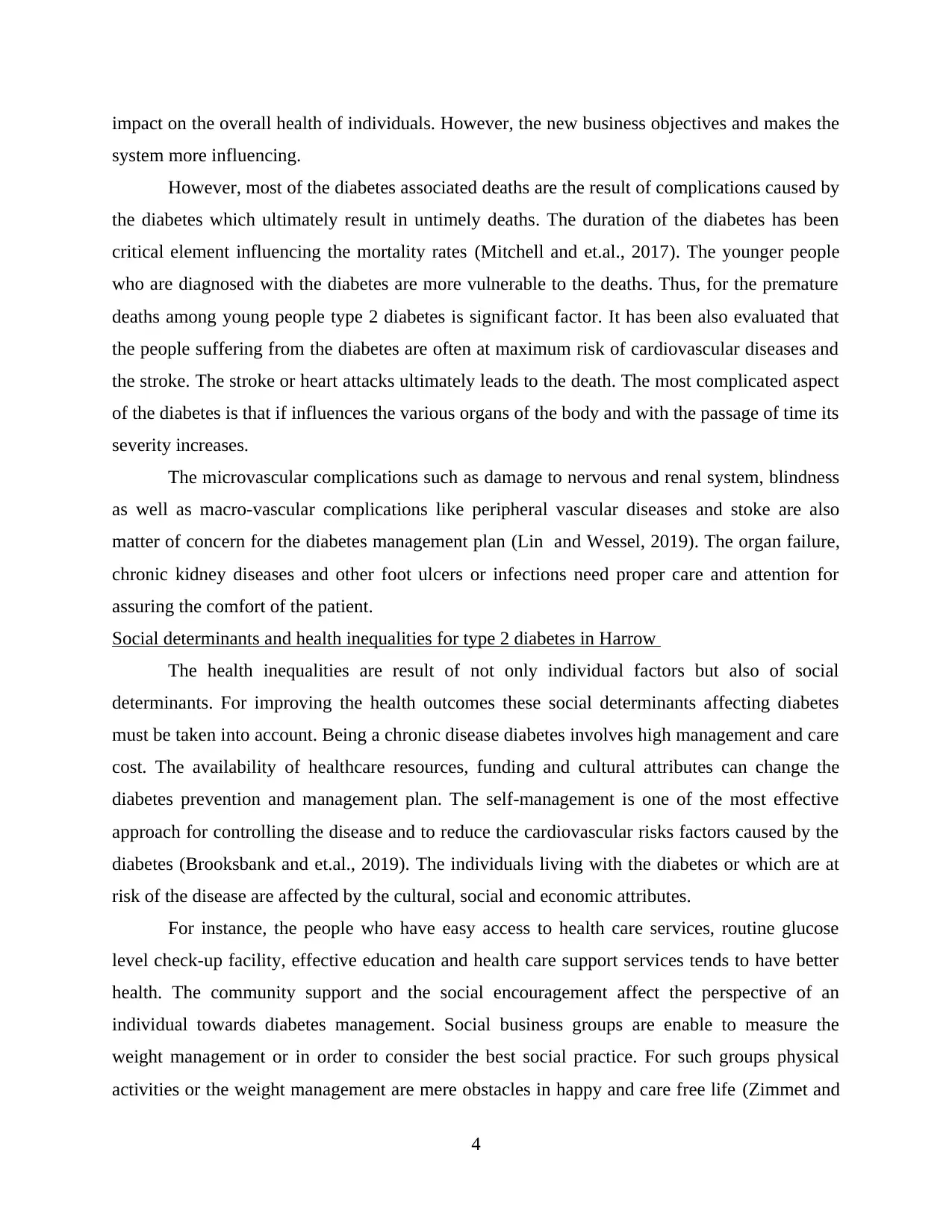
impact on the overall health of individuals. However, the new business objectives and makes the
system more influencing.
However, most of the diabetes associated deaths are the result of complications caused by
the diabetes which ultimately result in untimely deaths. The duration of the diabetes has been
critical element influencing the mortality rates (Mitchell and et.al., 2017). The younger people
who are diagnosed with the diabetes are more vulnerable to the deaths. Thus, for the premature
deaths among young people type 2 diabetes is significant factor. It has been also evaluated that
the people suffering from the diabetes are often at maximum risk of cardiovascular diseases and
the stroke. The stroke or heart attacks ultimately leads to the death. The most complicated aspect
of the diabetes is that if influences the various organs of the body and with the passage of time its
severity increases.
The microvascular complications such as damage to nervous and renal system, blindness
as well as macro-vascular complications like peripheral vascular diseases and stoke are also
matter of concern for the diabetes management plan (Lin and Wessel, 2019). The organ failure,
chronic kidney diseases and other foot ulcers or infections need proper care and attention for
assuring the comfort of the patient.
Social determinants and health inequalities for type 2 diabetes in Harrow
The health inequalities are result of not only individual factors but also of social
determinants. For improving the health outcomes these social determinants affecting diabetes
must be taken into account. Being a chronic disease diabetes involves high management and care
cost. The availability of healthcare resources, funding and cultural attributes can change the
diabetes prevention and management plan. The self-management is one of the most effective
approach for controlling the disease and to reduce the cardiovascular risks factors caused by the
diabetes (Brooksbank and et.al., 2019). The individuals living with the diabetes or which are at
risk of the disease are affected by the cultural, social and economic attributes.
For instance, the people who have easy access to health care services, routine glucose
level check-up facility, effective education and health care support services tends to have better
health. The community support and the social encouragement affect the perspective of an
individual towards diabetes management. Social business groups are enable to measure the
weight management or in order to consider the best social practice. For such groups physical
activities or the weight management are mere obstacles in happy and care free life (Zimmet and
4
system more influencing.
However, most of the diabetes associated deaths are the result of complications caused by
the diabetes which ultimately result in untimely deaths. The duration of the diabetes has been
critical element influencing the mortality rates (Mitchell and et.al., 2017). The younger people
who are diagnosed with the diabetes are more vulnerable to the deaths. Thus, for the premature
deaths among young people type 2 diabetes is significant factor. It has been also evaluated that
the people suffering from the diabetes are often at maximum risk of cardiovascular diseases and
the stroke. The stroke or heart attacks ultimately leads to the death. The most complicated aspect
of the diabetes is that if influences the various organs of the body and with the passage of time its
severity increases.
The microvascular complications such as damage to nervous and renal system, blindness
as well as macro-vascular complications like peripheral vascular diseases and stoke are also
matter of concern for the diabetes management plan (Lin and Wessel, 2019). The organ failure,
chronic kidney diseases and other foot ulcers or infections need proper care and attention for
assuring the comfort of the patient.
Social determinants and health inequalities for type 2 diabetes in Harrow
The health inequalities are result of not only individual factors but also of social
determinants. For improving the health outcomes these social determinants affecting diabetes
must be taken into account. Being a chronic disease diabetes involves high management and care
cost. The availability of healthcare resources, funding and cultural attributes can change the
diabetes prevention and management plan. The self-management is one of the most effective
approach for controlling the disease and to reduce the cardiovascular risks factors caused by the
diabetes (Brooksbank and et.al., 2019). The individuals living with the diabetes or which are at
risk of the disease are affected by the cultural, social and economic attributes.
For instance, the people who have easy access to health care services, routine glucose
level check-up facility, effective education and health care support services tends to have better
health. The community support and the social encouragement affect the perspective of an
individual towards diabetes management. Social business groups are enable to measure the
weight management or in order to consider the best social practice. For such groups physical
activities or the weight management are mere obstacles in happy and care free life (Zimmet and
4
⊘ This is a preview!⊘
Do you want full access?
Subscribe today to unlock all pages.

Trusted by 1+ million students worldwide
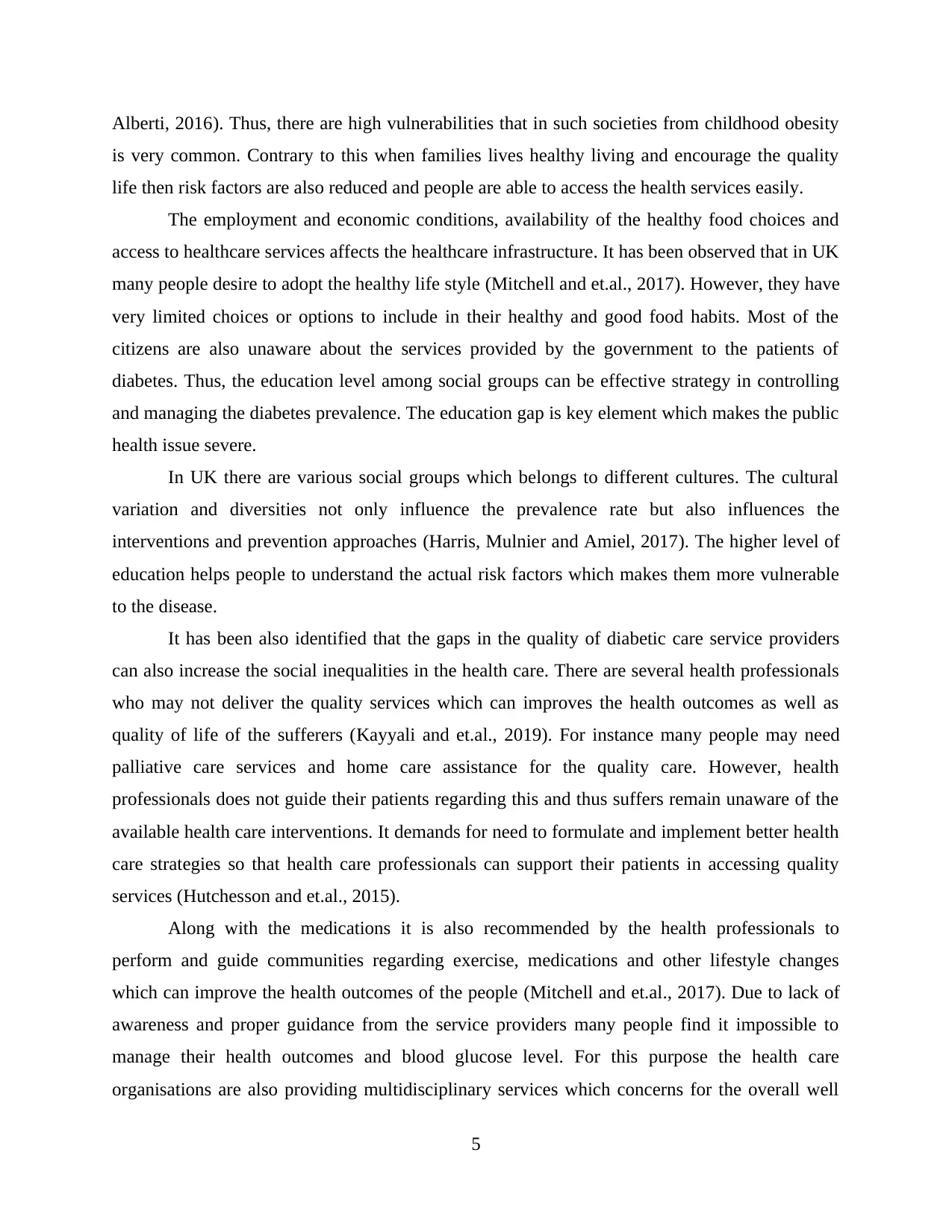
Alberti, 2016). Thus, there are high vulnerabilities that in such societies from childhood obesity
is very common. Contrary to this when families lives healthy living and encourage the quality
life then risk factors are also reduced and people are able to access the health services easily.
The employment and economic conditions, availability of the healthy food choices and
access to healthcare services affects the healthcare infrastructure. It has been observed that in UK
many people desire to adopt the healthy life style (Mitchell and et.al., 2017). However, they have
very limited choices or options to include in their healthy and good food habits. Most of the
citizens are also unaware about the services provided by the government to the patients of
diabetes. Thus, the education level among social groups can be effective strategy in controlling
and managing the diabetes prevalence. The education gap is key element which makes the public
health issue severe.
In UK there are various social groups which belongs to different cultures. The cultural
variation and diversities not only influence the prevalence rate but also influences the
interventions and prevention approaches (Harris, Mulnier and Amiel, 2017). The higher level of
education helps people to understand the actual risk factors which makes them more vulnerable
to the disease.
It has been also identified that the gaps in the quality of diabetic care service providers
can also increase the social inequalities in the health care. There are several health professionals
who may not deliver the quality services which can improves the health outcomes as well as
quality of life of the sufferers (Kayyali and et.al., 2019). For instance many people may need
palliative care services and home care assistance for the quality care. However, health
professionals does not guide their patients regarding this and thus suffers remain unaware of the
available health care interventions. It demands for need to formulate and implement better health
care strategies so that health care professionals can support their patients in accessing quality
services (Hutchesson and et.al., 2015).
Along with the medications it is also recommended by the health professionals to
perform and guide communities regarding exercise, medications and other lifestyle changes
which can improve the health outcomes of the people (Mitchell and et.al., 2017). Due to lack of
awareness and proper guidance from the service providers many people find it impossible to
manage their health outcomes and blood glucose level. For this purpose the health care
organisations are also providing multidisciplinary services which concerns for the overall well
5
is very common. Contrary to this when families lives healthy living and encourage the quality
life then risk factors are also reduced and people are able to access the health services easily.
The employment and economic conditions, availability of the healthy food choices and
access to healthcare services affects the healthcare infrastructure. It has been observed that in UK
many people desire to adopt the healthy life style (Mitchell and et.al., 2017). However, they have
very limited choices or options to include in their healthy and good food habits. Most of the
citizens are also unaware about the services provided by the government to the patients of
diabetes. Thus, the education level among social groups can be effective strategy in controlling
and managing the diabetes prevalence. The education gap is key element which makes the public
health issue severe.
In UK there are various social groups which belongs to different cultures. The cultural
variation and diversities not only influence the prevalence rate but also influences the
interventions and prevention approaches (Harris, Mulnier and Amiel, 2017). The higher level of
education helps people to understand the actual risk factors which makes them more vulnerable
to the disease.
It has been also identified that the gaps in the quality of diabetic care service providers
can also increase the social inequalities in the health care. There are several health professionals
who may not deliver the quality services which can improves the health outcomes as well as
quality of life of the sufferers (Kayyali and et.al., 2019). For instance many people may need
palliative care services and home care assistance for the quality care. However, health
professionals does not guide their patients regarding this and thus suffers remain unaware of the
available health care interventions. It demands for need to formulate and implement better health
care strategies so that health care professionals can support their patients in accessing quality
services (Hutchesson and et.al., 2015).
Along with the medications it is also recommended by the health professionals to
perform and guide communities regarding exercise, medications and other lifestyle changes
which can improve the health outcomes of the people (Mitchell and et.al., 2017). Due to lack of
awareness and proper guidance from the service providers many people find it impossible to
manage their health outcomes and blood glucose level. For this purpose the health care
organisations are also providing multidisciplinary services which concerns for the overall well
5
Paraphrase This Document
Need a fresh take? Get an instant paraphrase of this document with our AI Paraphraser
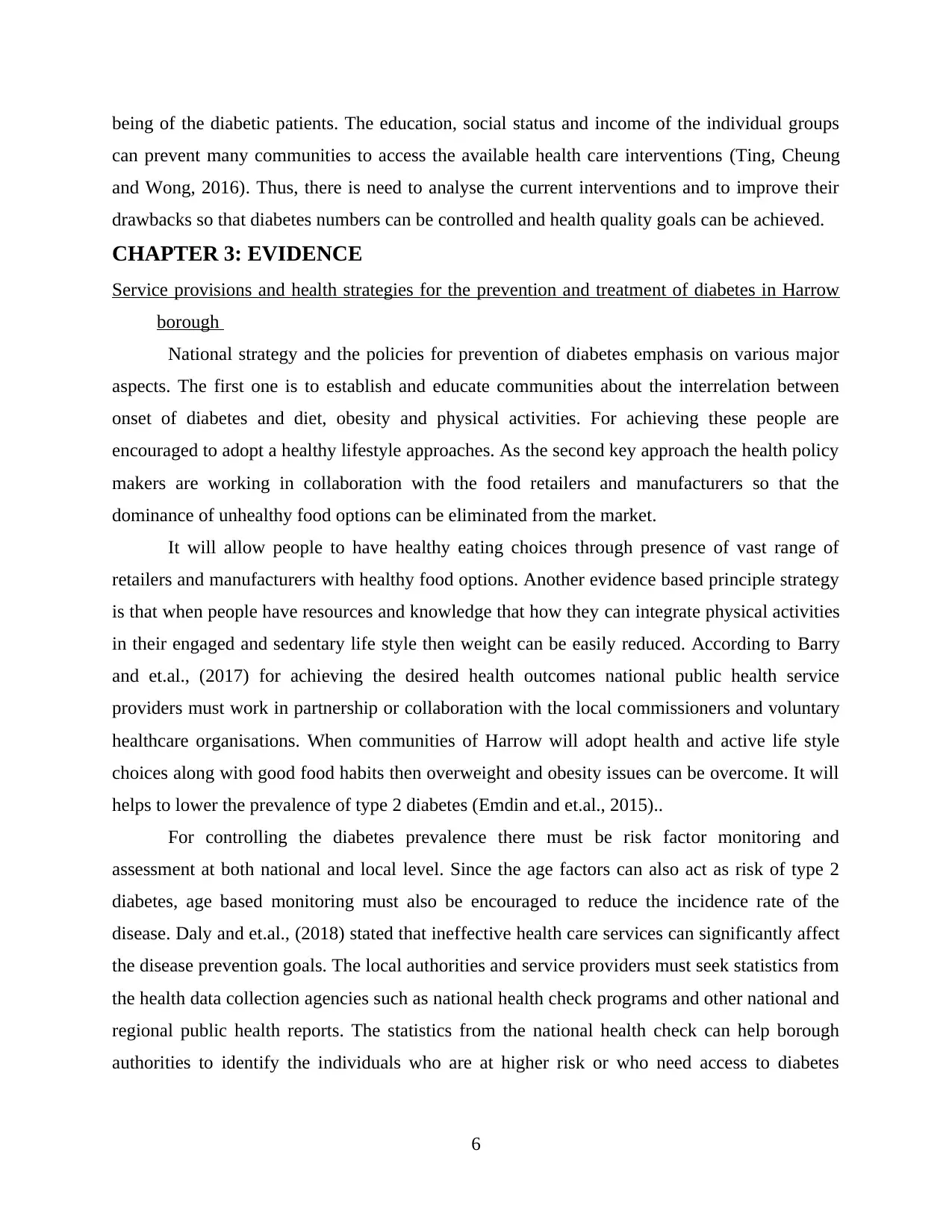
being of the diabetic patients. The education, social status and income of the individual groups
can prevent many communities to access the available health care interventions (Ting, Cheung
and Wong, 2016). Thus, there is need to analyse the current interventions and to improve their
drawbacks so that diabetes numbers can be controlled and health quality goals can be achieved.
CHAPTER 3: EVIDENCE
Service provisions and health strategies for the prevention and treatment of diabetes in Harrow
borough
National strategy and the policies for prevention of diabetes emphasis on various major
aspects. The first one is to establish and educate communities about the interrelation between
onset of diabetes and diet, obesity and physical activities. For achieving these people are
encouraged to adopt a healthy lifestyle approaches. As the second key approach the health policy
makers are working in collaboration with the food retailers and manufacturers so that the
dominance of unhealthy food options can be eliminated from the market.
It will allow people to have healthy eating choices through presence of vast range of
retailers and manufacturers with healthy food options. Another evidence based principle strategy
is that when people have resources and knowledge that how they can integrate physical activities
in their engaged and sedentary life style then weight can be easily reduced. According to Barry
and et.al., (2017) for achieving the desired health outcomes national public health service
providers must work in partnership or collaboration with the local commissioners and voluntary
healthcare organisations. When communities of Harrow will adopt health and active life style
choices along with good food habits then overweight and obesity issues can be overcome. It will
helps to lower the prevalence of type 2 diabetes (Emdin and et.al., 2015)..
For controlling the diabetes prevalence there must be risk factor monitoring and
assessment at both national and local level. Since the age factors can also act as risk of type 2
diabetes, age based monitoring must also be encouraged to reduce the incidence rate of the
disease. Daly and et.al., (2018) stated that ineffective health care services can significantly affect
the disease prevention goals. The local authorities and service providers must seek statistics from
the health data collection agencies such as national health check programs and other national and
regional public health reports. The statistics from the national health check can help borough
authorities to identify the individuals who are at higher risk or who need access to diabetes
6
can prevent many communities to access the available health care interventions (Ting, Cheung
and Wong, 2016). Thus, there is need to analyse the current interventions and to improve their
drawbacks so that diabetes numbers can be controlled and health quality goals can be achieved.
CHAPTER 3: EVIDENCE
Service provisions and health strategies for the prevention and treatment of diabetes in Harrow
borough
National strategy and the policies for prevention of diabetes emphasis on various major
aspects. The first one is to establish and educate communities about the interrelation between
onset of diabetes and diet, obesity and physical activities. For achieving these people are
encouraged to adopt a healthy lifestyle approaches. As the second key approach the health policy
makers are working in collaboration with the food retailers and manufacturers so that the
dominance of unhealthy food options can be eliminated from the market.
It will allow people to have healthy eating choices through presence of vast range of
retailers and manufacturers with healthy food options. Another evidence based principle strategy
is that when people have resources and knowledge that how they can integrate physical activities
in their engaged and sedentary life style then weight can be easily reduced. According to Barry
and et.al., (2017) for achieving the desired health outcomes national public health service
providers must work in partnership or collaboration with the local commissioners and voluntary
healthcare organisations. When communities of Harrow will adopt health and active life style
choices along with good food habits then overweight and obesity issues can be overcome. It will
helps to lower the prevalence of type 2 diabetes (Emdin and et.al., 2015)..
For controlling the diabetes prevalence there must be risk factor monitoring and
assessment at both national and local level. Since the age factors can also act as risk of type 2
diabetes, age based monitoring must also be encouraged to reduce the incidence rate of the
disease. Daly and et.al., (2018) stated that ineffective health care services can significantly affect
the disease prevention goals. The local authorities and service providers must seek statistics from
the health data collection agencies such as national health check programs and other national and
regional public health reports. The statistics from the national health check can help borough
authorities to identify the individuals who are at higher risk or who need access to diabetes
6
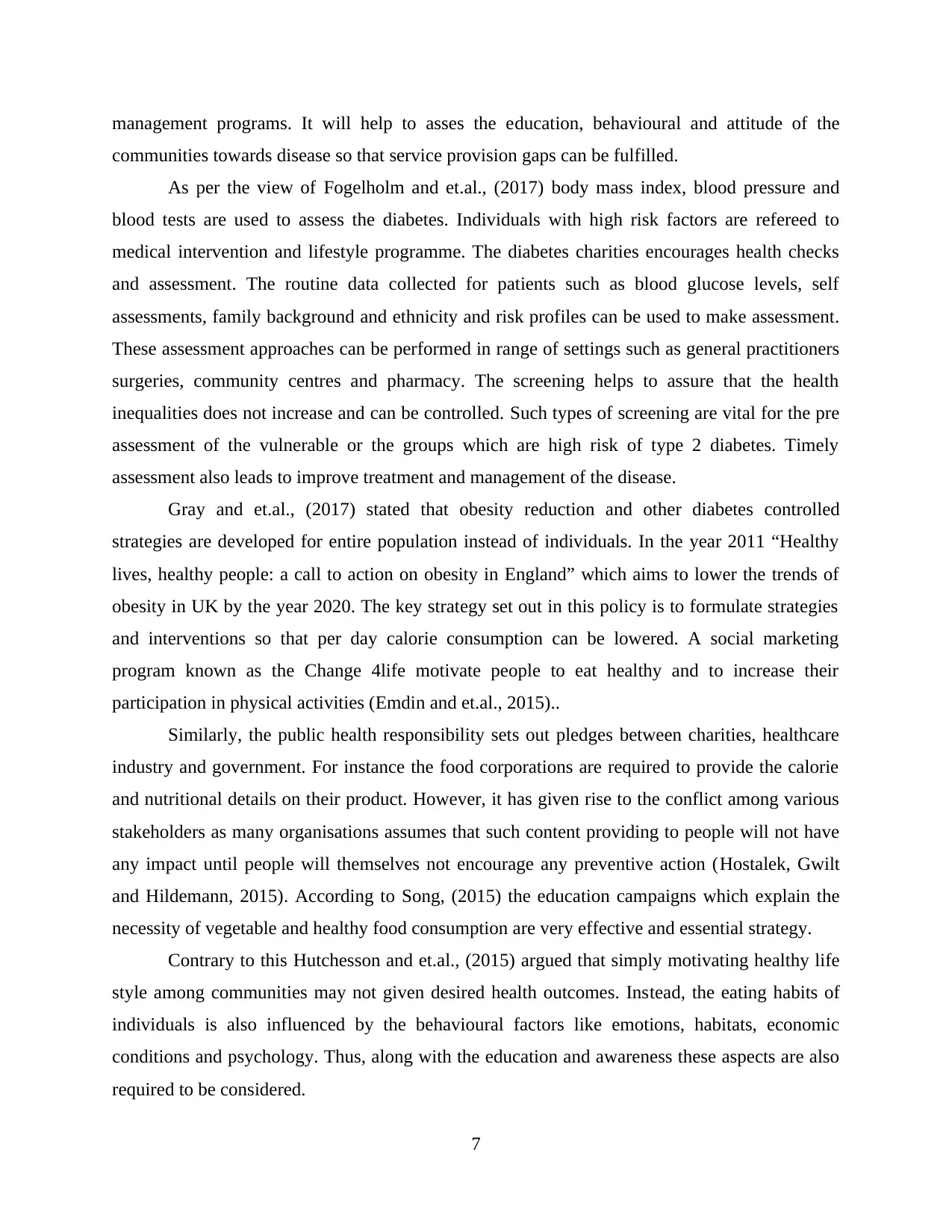
management programs. It will help to asses the education, behavioural and attitude of the
communities towards disease so that service provision gaps can be fulfilled.
As per the view of Fogelholm and et.al., (2017) body mass index, blood pressure and
blood tests are used to assess the diabetes. Individuals with high risk factors are refereed to
medical intervention and lifestyle programme. The diabetes charities encourages health checks
and assessment. The routine data collected for patients such as blood glucose levels, self
assessments, family background and ethnicity and risk profiles can be used to make assessment.
These assessment approaches can be performed in range of settings such as general practitioners
surgeries, community centres and pharmacy. The screening helps to assure that the health
inequalities does not increase and can be controlled. Such types of screening are vital for the pre
assessment of the vulnerable or the groups which are high risk of type 2 diabetes. Timely
assessment also leads to improve treatment and management of the disease.
Gray and et.al., (2017) stated that obesity reduction and other diabetes controlled
strategies are developed for entire population instead of individuals. In the year 2011 “Healthy
lives, healthy people: a call to action on obesity in England” which aims to lower the trends of
obesity in UK by the year 2020. The key strategy set out in this policy is to formulate strategies
and interventions so that per day calorie consumption can be lowered. A social marketing
program known as the Change 4life motivate people to eat healthy and to increase their
participation in physical activities (Emdin and et.al., 2015)..
Similarly, the public health responsibility sets out pledges between charities, healthcare
industry and government. For instance the food corporations are required to provide the calorie
and nutritional details on their product. However, it has given rise to the conflict among various
stakeholders as many organisations assumes that such content providing to people will not have
any impact until people will themselves not encourage any preventive action (Hostalek, Gwilt
and Hildemann, 2015). According to Song, (2015) the education campaigns which explain the
necessity of vegetable and healthy food consumption are very effective and essential strategy.
Contrary to this Hutchesson and et.al., (2015) argued that simply motivating healthy life
style among communities may not given desired health outcomes. Instead, the eating habits of
individuals is also influenced by the behavioural factors like emotions, habitats, economic
conditions and psychology. Thus, along with the education and awareness these aspects are also
required to be considered.
7
communities towards disease so that service provision gaps can be fulfilled.
As per the view of Fogelholm and et.al., (2017) body mass index, blood pressure and
blood tests are used to assess the diabetes. Individuals with high risk factors are refereed to
medical intervention and lifestyle programme. The diabetes charities encourages health checks
and assessment. The routine data collected for patients such as blood glucose levels, self
assessments, family background and ethnicity and risk profiles can be used to make assessment.
These assessment approaches can be performed in range of settings such as general practitioners
surgeries, community centres and pharmacy. The screening helps to assure that the health
inequalities does not increase and can be controlled. Such types of screening are vital for the pre
assessment of the vulnerable or the groups which are high risk of type 2 diabetes. Timely
assessment also leads to improve treatment and management of the disease.
Gray and et.al., (2017) stated that obesity reduction and other diabetes controlled
strategies are developed for entire population instead of individuals. In the year 2011 “Healthy
lives, healthy people: a call to action on obesity in England” which aims to lower the trends of
obesity in UK by the year 2020. The key strategy set out in this policy is to formulate strategies
and interventions so that per day calorie consumption can be lowered. A social marketing
program known as the Change 4life motivate people to eat healthy and to increase their
participation in physical activities (Emdin and et.al., 2015)..
Similarly, the public health responsibility sets out pledges between charities, healthcare
industry and government. For instance the food corporations are required to provide the calorie
and nutritional details on their product. However, it has given rise to the conflict among various
stakeholders as many organisations assumes that such content providing to people will not have
any impact until people will themselves not encourage any preventive action (Hostalek, Gwilt
and Hildemann, 2015). According to Song, (2015) the education campaigns which explain the
necessity of vegetable and healthy food consumption are very effective and essential strategy.
Contrary to this Hutchesson and et.al., (2015) argued that simply motivating healthy life
style among communities may not given desired health outcomes. Instead, the eating habits of
individuals is also influenced by the behavioural factors like emotions, habitats, economic
conditions and psychology. Thus, along with the education and awareness these aspects are also
required to be considered.
7
⊘ This is a preview!⊘
Do you want full access?
Subscribe today to unlock all pages.

Trusted by 1+ million students worldwide
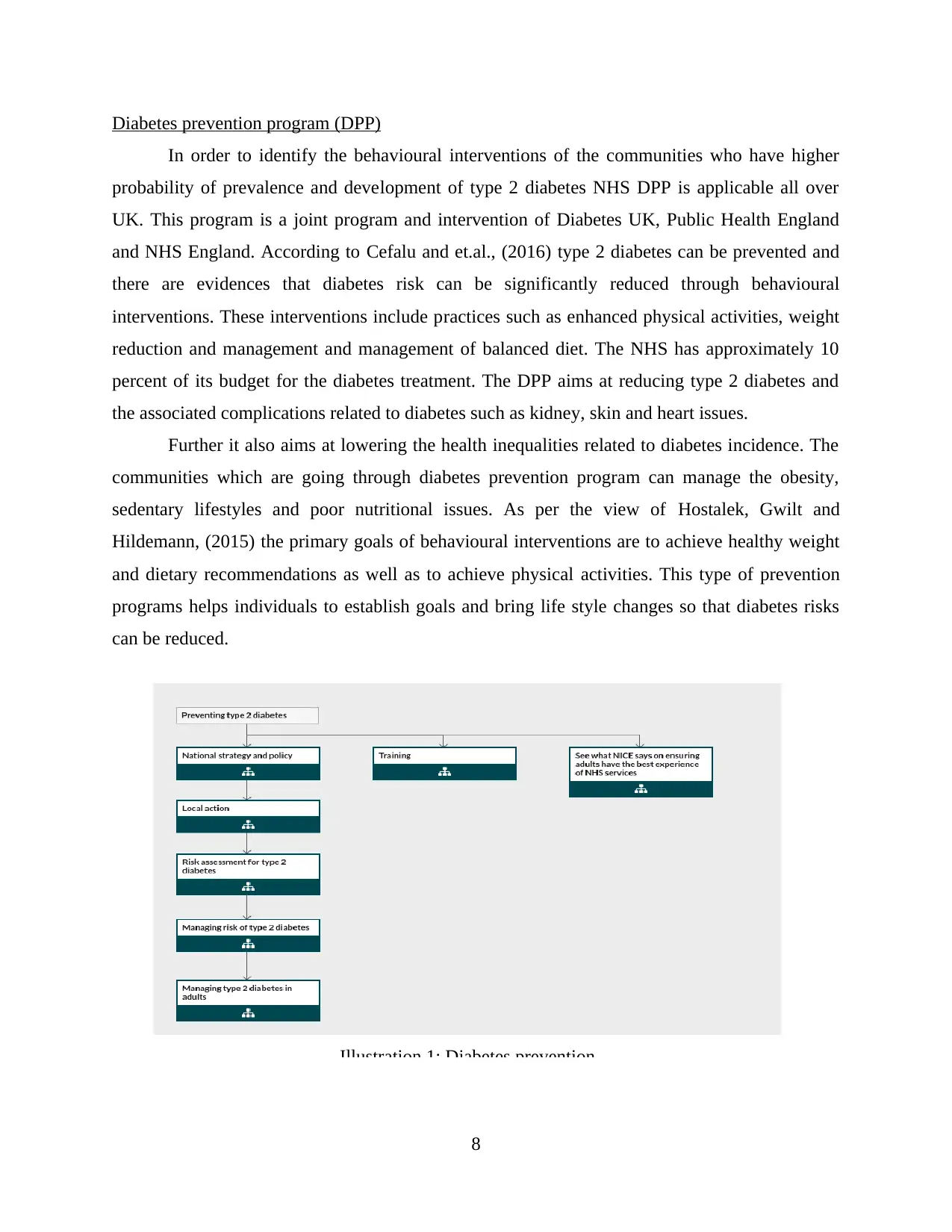
Diabetes prevention program (DPP)
In order to identify the behavioural interventions of the communities who have higher
probability of prevalence and development of type 2 diabetes NHS DPP is applicable all over
UK. This program is a joint program and intervention of Diabetes UK, Public Health England
and NHS England. According to Cefalu and et.al., (2016) type 2 diabetes can be prevented and
there are evidences that diabetes risk can be significantly reduced through behavioural
interventions. These interventions include practices such as enhanced physical activities, weight
reduction and management and management of balanced diet. The NHS has approximately 10
percent of its budget for the diabetes treatment. The DPP aims at reducing type 2 diabetes and
the associated complications related to diabetes such as kidney, skin and heart issues.
Further it also aims at lowering the health inequalities related to diabetes incidence. The
communities which are going through diabetes prevention program can manage the obesity,
sedentary lifestyles and poor nutritional issues. As per the view of Hostalek, Gwilt and
Hildemann, (2015) the primary goals of behavioural interventions are to achieve healthy weight
and dietary recommendations as well as to achieve physical activities. This type of prevention
programs helps individuals to establish goals and bring life style changes so that diabetes risks
can be reduced.
8
Illustration 1: Diabetes prevention
In order to identify the behavioural interventions of the communities who have higher
probability of prevalence and development of type 2 diabetes NHS DPP is applicable all over
UK. This program is a joint program and intervention of Diabetes UK, Public Health England
and NHS England. According to Cefalu and et.al., (2016) type 2 diabetes can be prevented and
there are evidences that diabetes risk can be significantly reduced through behavioural
interventions. These interventions include practices such as enhanced physical activities, weight
reduction and management and management of balanced diet. The NHS has approximately 10
percent of its budget for the diabetes treatment. The DPP aims at reducing type 2 diabetes and
the associated complications related to diabetes such as kidney, skin and heart issues.
Further it also aims at lowering the health inequalities related to diabetes incidence. The
communities which are going through diabetes prevention program can manage the obesity,
sedentary lifestyles and poor nutritional issues. As per the view of Hostalek, Gwilt and
Hildemann, (2015) the primary goals of behavioural interventions are to achieve healthy weight
and dietary recommendations as well as to achieve physical activities. This type of prevention
programs helps individuals to establish goals and bring life style changes so that diabetes risks
can be reduced.
8
Illustration 1: Diabetes prevention
Paraphrase This Document
Need a fresh take? Get an instant paraphrase of this document with our AI Paraphraser
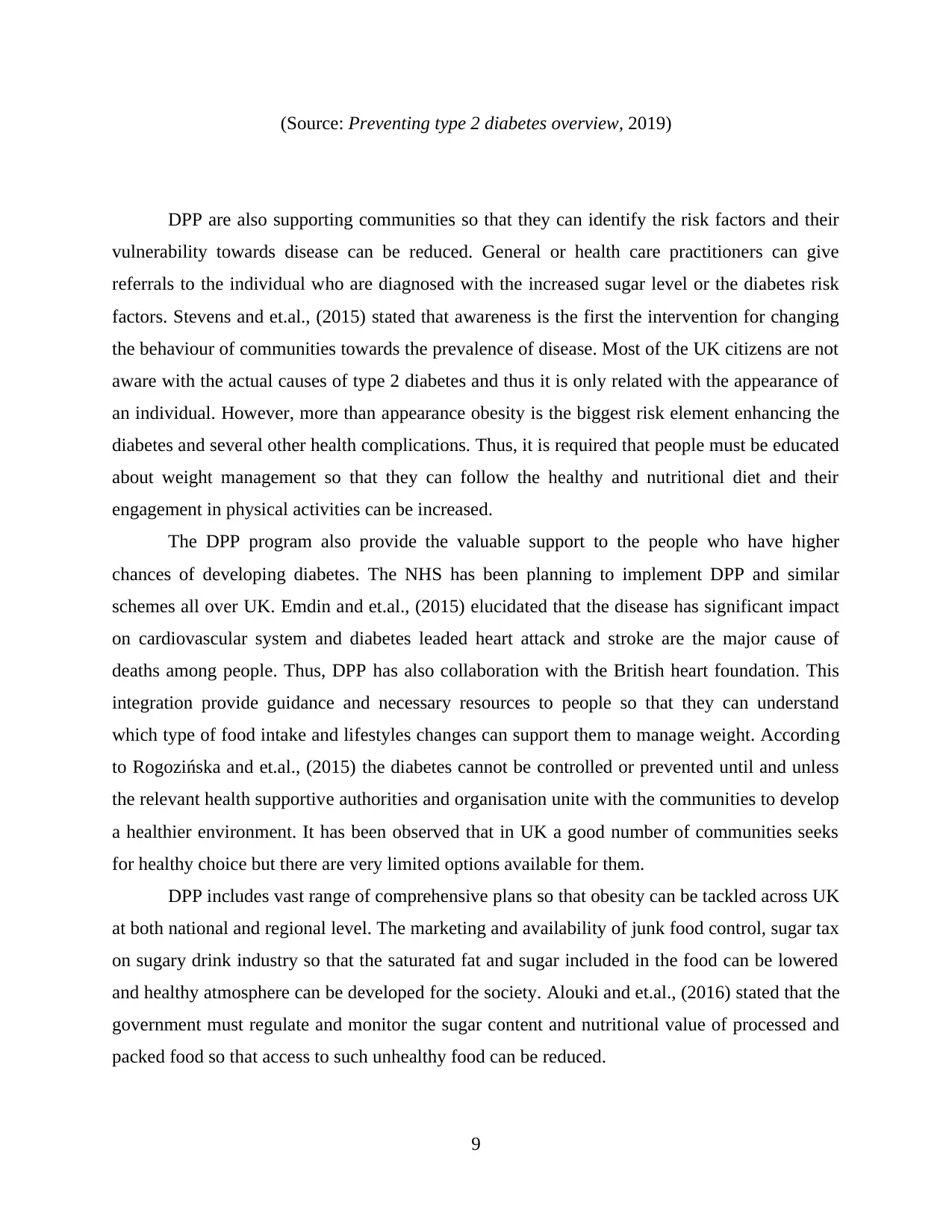
(Source: Preventing type 2 diabetes overview, 2019)
DPP are also supporting communities so that they can identify the risk factors and their
vulnerability towards disease can be reduced. General or health care practitioners can give
referrals to the individual who are diagnosed with the increased sugar level or the diabetes risk
factors. Stevens and et.al., (2015) stated that awareness is the first the intervention for changing
the behaviour of communities towards the prevalence of disease. Most of the UK citizens are not
aware with the actual causes of type 2 diabetes and thus it is only related with the appearance of
an individual. However, more than appearance obesity is the biggest risk element enhancing the
diabetes and several other health complications. Thus, it is required that people must be educated
about weight management so that they can follow the healthy and nutritional diet and their
engagement in physical activities can be increased.
The DPP program also provide the valuable support to the people who have higher
chances of developing diabetes. The NHS has been planning to implement DPP and similar
schemes all over UK. Emdin and et.al., (2015) elucidated that the disease has significant impact
on cardiovascular system and diabetes leaded heart attack and stroke are the major cause of
deaths among people. Thus, DPP has also collaboration with the British heart foundation. This
integration provide guidance and necessary resources to people so that they can understand
which type of food intake and lifestyles changes can support them to manage weight. According
to Rogozińska and et.al., (2015) the diabetes cannot be controlled or prevented until and unless
the relevant health supportive authorities and organisation unite with the communities to develop
a healthier environment. It has been observed that in UK a good number of communities seeks
for healthy choice but there are very limited options available for them.
DPP includes vast range of comprehensive plans so that obesity can be tackled across UK
at both national and regional level. The marketing and availability of junk food control, sugar tax
on sugary drink industry so that the saturated fat and sugar included in the food can be lowered
and healthy atmosphere can be developed for the society. Alouki and et.al., (2016) stated that the
government must regulate and monitor the sugar content and nutritional value of processed and
packed food so that access to such unhealthy food can be reduced.
9
DPP are also supporting communities so that they can identify the risk factors and their
vulnerability towards disease can be reduced. General or health care practitioners can give
referrals to the individual who are diagnosed with the increased sugar level or the diabetes risk
factors. Stevens and et.al., (2015) stated that awareness is the first the intervention for changing
the behaviour of communities towards the prevalence of disease. Most of the UK citizens are not
aware with the actual causes of type 2 diabetes and thus it is only related with the appearance of
an individual. However, more than appearance obesity is the biggest risk element enhancing the
diabetes and several other health complications. Thus, it is required that people must be educated
about weight management so that they can follow the healthy and nutritional diet and their
engagement in physical activities can be increased.
The DPP program also provide the valuable support to the people who have higher
chances of developing diabetes. The NHS has been planning to implement DPP and similar
schemes all over UK. Emdin and et.al., (2015) elucidated that the disease has significant impact
on cardiovascular system and diabetes leaded heart attack and stroke are the major cause of
deaths among people. Thus, DPP has also collaboration with the British heart foundation. This
integration provide guidance and necessary resources to people so that they can understand
which type of food intake and lifestyles changes can support them to manage weight. According
to Rogozińska and et.al., (2015) the diabetes cannot be controlled or prevented until and unless
the relevant health supportive authorities and organisation unite with the communities to develop
a healthier environment. It has been observed that in UK a good number of communities seeks
for healthy choice but there are very limited options available for them.
DPP includes vast range of comprehensive plans so that obesity can be tackled across UK
at both national and regional level. The marketing and availability of junk food control, sugar tax
on sugary drink industry so that the saturated fat and sugar included in the food can be lowered
and healthy atmosphere can be developed for the society. Alouki and et.al., (2016) stated that the
government must regulate and monitor the sugar content and nutritional value of processed and
packed food so that access to such unhealthy food can be reduced.
9
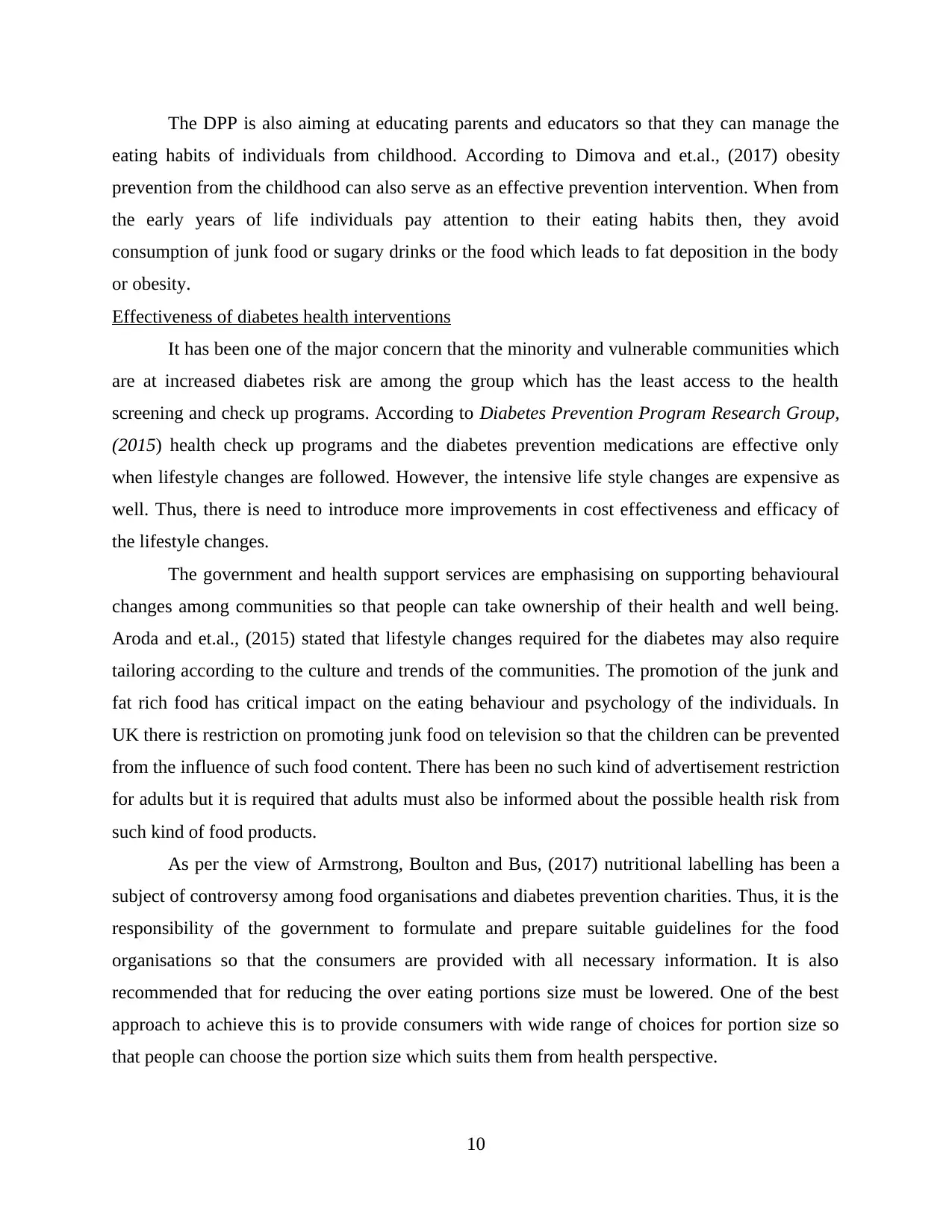
The DPP is also aiming at educating parents and educators so that they can manage the
eating habits of individuals from childhood. According to Dimova and et.al., (2017) obesity
prevention from the childhood can also serve as an effective prevention intervention. When from
the early years of life individuals pay attention to their eating habits then, they avoid
consumption of junk food or sugary drinks or the food which leads to fat deposition in the body
or obesity.
Effectiveness of diabetes health interventions
It has been one of the major concern that the minority and vulnerable communities which
are at increased diabetes risk are among the group which has the least access to the health
screening and check up programs. According to Diabetes Prevention Program Research Group,
(2015) health check up programs and the diabetes prevention medications are effective only
when lifestyle changes are followed. However, the intensive life style changes are expensive as
well. Thus, there is need to introduce more improvements in cost effectiveness and efficacy of
the lifestyle changes.
The government and health support services are emphasising on supporting behavioural
changes among communities so that people can take ownership of their health and well being.
Aroda and et.al., (2015) stated that lifestyle changes required for the diabetes may also require
tailoring according to the culture and trends of the communities. The promotion of the junk and
fat rich food has critical impact on the eating behaviour and psychology of the individuals. In
UK there is restriction on promoting junk food on television so that the children can be prevented
from the influence of such food content. There has been no such kind of advertisement restriction
for adults but it is required that adults must also be informed about the possible health risk from
such kind of food products.
As per the view of Armstrong, Boulton and Bus, (2017) nutritional labelling has been a
subject of controversy among food organisations and diabetes prevention charities. Thus, it is the
responsibility of the government to formulate and prepare suitable guidelines for the food
organisations so that the consumers are provided with all necessary information. It is also
recommended that for reducing the over eating portions size must be lowered. One of the best
approach to achieve this is to provide consumers with wide range of choices for portion size so
that people can choose the portion size which suits them from health perspective.
10
eating habits of individuals from childhood. According to Dimova and et.al., (2017) obesity
prevention from the childhood can also serve as an effective prevention intervention. When from
the early years of life individuals pay attention to their eating habits then, they avoid
consumption of junk food or sugary drinks or the food which leads to fat deposition in the body
or obesity.
Effectiveness of diabetes health interventions
It has been one of the major concern that the minority and vulnerable communities which
are at increased diabetes risk are among the group which has the least access to the health
screening and check up programs. According to Diabetes Prevention Program Research Group,
(2015) health check up programs and the diabetes prevention medications are effective only
when lifestyle changes are followed. However, the intensive life style changes are expensive as
well. Thus, there is need to introduce more improvements in cost effectiveness and efficacy of
the lifestyle changes.
The government and health support services are emphasising on supporting behavioural
changes among communities so that people can take ownership of their health and well being.
Aroda and et.al., (2015) stated that lifestyle changes required for the diabetes may also require
tailoring according to the culture and trends of the communities. The promotion of the junk and
fat rich food has critical impact on the eating behaviour and psychology of the individuals. In
UK there is restriction on promoting junk food on television so that the children can be prevented
from the influence of such food content. There has been no such kind of advertisement restriction
for adults but it is required that adults must also be informed about the possible health risk from
such kind of food products.
As per the view of Armstrong, Boulton and Bus, (2017) nutritional labelling has been a
subject of controversy among food organisations and diabetes prevention charities. Thus, it is the
responsibility of the government to formulate and prepare suitable guidelines for the food
organisations so that the consumers are provided with all necessary information. It is also
recommended that for reducing the over eating portions size must be lowered. One of the best
approach to achieve this is to provide consumers with wide range of choices for portion size so
that people can choose the portion size which suits them from health perspective.
10
⊘ This is a preview!⊘
Do you want full access?
Subscribe today to unlock all pages.

Trusted by 1+ million students worldwide
1 out of 26
Related Documents
Your All-in-One AI-Powered Toolkit for Academic Success.
+13062052269
info@desklib.com
Available 24*7 on WhatsApp / Email
![[object Object]](/_next/static/media/star-bottom.7253800d.svg)
Unlock your academic potential
Copyright © 2020–2025 A2Z Services. All Rights Reserved. Developed and managed by ZUCOL.





